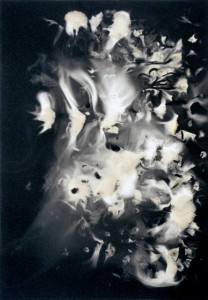
Jim Toia teaches a course in the Williams Visual Arts Building.
For Jim Toia, director of community-based teaching, there was no “aha” moment when he discovered a passion for art – it was always there. With the living environment as his muse, Toia continually explores and expands human awareness of the natural world.
“I am stunned by [nature’s] ability to display unbelievable beauty at one moment and horrific terror at the next,” he explains. “I employ, encourage, and entice nature to act on its own in a way that allows us to capture or unveil many of its properties and actions. For instance, saturating a spent ant colony with molten pewter and then unearthing it like an anthropological dig reveals the colony structure in a way we could never anticipate or experience.”
Toia’s work is featured in two current exhibits. Buds, Blooms & Berries: Plants in Science, Culture & Art runs through Dec. 31 at the Everhart Museum in Scranton, Pa. His mushroom spore drawings are featured in the Sticks and Stones exhibit that runs through Jan. 6, 2012, at the Lehman College Art Gallery in New York City.
By allowing mushrooms to spore on paper, Toia captures a process that occurs daily but often goes unnoticed because it happens slowly and minimally in nature. In his work, he confines how far the spores can travel so that their masses pile up in a way that allows viewers to witness the process.

"Warm Blood Cold Waters" by Jim Toia
Being a working artist doesn’t only benefit Toia’s creative appetite, it also allows his students to learn in a collaborative environment where each artist has something to contribute to the artistic process. He relishes the role he plays in showing his students that their art is a viable career goal.
“It is exceptionally important for students to understand that they have the ability to affect people’s views and ideas,” he says. “They have more ability and knowledge than they are aware, and they must only take it seriously and use their intelligence to be effective, successful artists. This goes for any and every person who enters the studio or classroom.”
Working with student artists also inspires Toia to stretch his creative boundaries. He says that Lafayette’s Community-Based Teaching Program has sharpened his desire to work in a more collaborative fashion.
He’s embarked on the ambitious new Petri Island Project, for which he hands out Petri dishes and asks participants to create their version of “what an island means to them.” He then arranges the dishes into an installation that changes based on location and result.
The Studios of Key West in Key West, Fla., awarded Toia a residency for this coming summer. He’s taking his Petri Island Project there, contacting every school in the Florida Keys to get as many people as possible to participate. Meghan Miklavic ’12 (Elizabeth, Maine), a psychology and art double major, is assisting Toia and may serve a summer internship in Key West.
“This is particularly poignant since the Florida Keys are a particularly sensitive and delicate environmental region,” he explains. “I am asking its residents to respond to their experiences there and to think about the vulnerability that affects them perhaps more directly than most people who live inland and throughout the majority of our country.”
Toia has exhibited his work throughout the United States, Europe, and the Far East. His work appears in many collections including the Morris Museum in Morristown, N.J., AT&T Collection, Dallas Museum of Art, and Hunterdon Museum of Art. He is represented in New York City by the Kim Foster Gallery in Chelsea and the Haines Gallery in San Francisco. He earned his bachelor’s degree at Bard College and a master’s of fine arts from the School of Visual Arts. He is the recipient of a 2000 New Jersey State Council on the Arts Fellowship and a Geraldine Dodge Foundation Grant.

